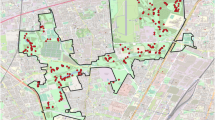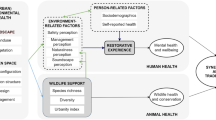Abstract
The research on the restorative capacity of various environments has been growing exponentially in recent years. However, previous researchers mainly focus on urban green spaces, natural environments or urban landscapes. The streetscapes which have a close tie with residents’ daily life and may have an essential effect on people’s psychological wellbeing have not attracted extensive attention from academic research, failing to provide a cohesive guideline for streetscape design. To address this gap, this paper conducted an experiment to explore the relationship between restorative quality and streetscape characteristics, in which 30 photographs representing the various streetscapes in Xuzhou in eastern China, were used as stimuli, and the restorative qualities of these photographs were measured through online surveys. The results indicated that: (1) the streetscape with higher rate of plants in the view and diverse species of plants implied a high restorative capacity; (2) less non-motor vehicles and clear traffic signs painted on the streets are the other promoters of the restorative capacity of streetscapes. These findings contribute new knowledge about the role of streetscape characteristics to enhance the restorative potential and have applications for designers and urban managers.
This is a preview of subscription content, access via your institution
Access options
Subscribe to this journal
Receive 6 print issues and online access
$259.00 per year
only $43.17 per issue
Buy this article
- Purchase on Springer Link
- Instant access to full article PDF
Prices may be subject to local taxes which are calculated during checkout


Similar content being viewed by others
References
Prince M, Patel V, Saxena S, Maj M, Maselko J, Phillips MR, et al. Global mental health 1—no health without mental health. Lancet. 2007;370:859–77.
Jiang B, Zhang T, Sullivan WC. Healthy cities: mechanism and research questions regarding the impacts of urban green landscapes on public health and well-being. Landsc Architecture Front. 2015;3:24–35.
Velarde MD, Fry G, Tveit M. Health effects of viewing landscapes—landscape types in environmental psychology. Urban Forestry Urban Green. 2007;6:199–212.
Kurdoglu O, Kurdoglu BC. Determining recreational, scenic, and historical cultural potentials of landscape features along a segment of the ancient Silk Road using factor analyzing. Environ Monit Assess. 2010;170:99–116.
Frumkin H. Beyond toxicity: human health and the natural environment. Am J Prev Med 2001;20:234–40.
Kaplan S. The restorative benefits of nature: toward an integrative framework. J Environ Psychol. 1995;15:169–82.
Park BJ, Furuya K, Kasetani T, Takayama N, Kagawa T, Miyazaki Y. Relationship between psychological responses and physical environments in forest settings. Landsc Urban Plan. 2011;102:24–32.
Ulrich RS, Simons RF, Losito BD, Fiorito E, Miles MA, Zelson M. Stress recovery during exposure to natural and urban environments. J Environ Psychol. 1991;11:201–30.
Aspinall P, Mavros P, Coyne R, Roe J. The urban brain: Analyzing outdoor physical activity with mobile EEG. Br J Sports Med. 2013;49:272–91.
van Den Berg AE, Custers MHG. Gardening promotes neuroen-docrine and affective restoration from stress. J Health Psychol. 2011;16:3–11.
Tyrväinen L, Ojala A, Korpela K, Lanki T, Tsunetsugu Y, Kagawa T. The influence of urban green environments on stress relief measures: a field experiment. J Environ Psychol. 2014;38:1–9.
Hansmann R, Hug SM, Seeland K. Restoration and stress relief through physical activities in forests and parks. Urban Forestry Urban Green. 2007;6:213–25.
Hartig T, Staats H. The need for psychological restoration as a determinant of environmental preference. J Environ Psychol. 2006;26:215–26.
Kaplan R, Kaplan S, Ryan R. With people in mind: design and management of everyday nature. Washington, D.C.: Island Press; 1998.
Li Q. Effect of forest bathing trips on human immune function. Environ Health Prev Med. 2010;15:9–17.
Jim CY, Chen SS. Comprehensive greenspace planning based on landscape ecology principles in compact Nanjing City, China. Landsc Urban Plan. 2003;65:95–116.
Tian S, Li J. Restoration and stress relief benefits of urban park ad green space. Chin Landsc Architecture. 2009;25:79–82. In Chinese.
Zhao J, Xu W, Ye L. Effects of auditory-visual combinations on perceived restorative potential of urban green space. Appl Acoust. 2018;141:169–77.
Jacobs AB. Keynote: looking, learning, making. Places. 1997;1:4–7.
Merriman P. Driving places: Marc Augé. Non-places, and the geographies of England’s M1 motorway. Theory Cult Soc. 2004;21:145–66.
Getz DA, Karow A, Kielbaso JJ. Inner city preferences for trees and urban forestry programs. J Arboric. 1982;8:258–63.
Lindal PJ, Hartig T. Effects of urban street vegetation on judgments of restoration likelihood. Urban For Urban Green. 2015;14:200–9.
Lin YH, Tsai CC, Sullivan WC, Chang PJ, Chang CY. Does awareness effect the restorative function and perception of street trees? Front Psychol. 2014;5:906.
van Dillen SME, de Vries S, Groenewegen PP, Spreeuwenberg P. Greenspace in urban neighbourhoods and residents’ health: adding quality to quantity. J Epidemiol Community Health. 2012;66:e8.
Lindal PJ, Hartig T. Architectural variation, building height, and the restorative quality of urban residential streetscapes. J Environ Psychol. 2013;33:26–36.
Bornioli A, Parkhurst G, Morgan PL. Psychological wellbeing benefits of simulated exposure to five urban settings: an experimental study from the pedestrian’s perspective. J Transp Health. 2018;9:105–16.
Bornioli A, Parkhurst G, Morgan PL. Affective experiences of built environments and the promotion of urban walking. Transp Res Part A: Policy Pract. 2019;123:200–15.
Völker S, Kistemann T. The impact of blue space on human health and well-being– Salutogenetic health effects of inland surface waters: a review. Int J Hyg Environ Health. 2011;214:449–60.
Völker S, Kistemann T. “I’m always entirely happy when I’m here!” Urban blue enhancing human health and well-being in Cologne and Düsseldorf, Germany. Soc Sci Med. 2013;78:113–24.
Jiang B, Chang CY, Sullivan WC. A dose of nature: tree cover, stress reduction, and gender differences. Landsc Urban Plan. 2014;132:26–36.
Nordh H, Hartig T, Hagerhall CM, Fry G. Components of small urban parks that predict the possibility for restoration. Urban For Urban Green. 2009;8:225–35.
Arriaza M, Canas-Ortega JF, Canas-Madueno JA, Ruiz-Aviles P. Assessing the visual quality of rural landscapes. Landsc Urban Plan. 2004;69:115–25.
Zhao J, Luo P, Wang R, Cai Y. Correlations between aesthetic preferences of river and landscape characters. J Environ Eng Landsc Manag. 2013;21:123–32.
Zhao J, Li R, Wei X. Assessing the aesthetic value of traditional gardens and urban parks in China. Urban Des Plan. 2017;170:1–9.
Holloway L, Hubbard P. People and place: the extraordinary geographies of everyday life. Harlow: Prentice Hall; 2011.
Amundsen I. The road through the landscape. Topos: Vakre veger. Road development and landscape architecture in Norway. München: Verlag Georg, D.W., Callwey, G. Co., K.G.; 2004. p. 43–55.
Taylor MS, Wheeler BW, White MP, Economou T, Osborne NJ. Research note: Urban street tree density and antidepressant prescription rates—a cross-sectional study in London, UK. Landsc Urban Plan. 2015;136:174–9.
Palmer JF, Hoffman RE. Rating reliability and representation validity in scenic landscape assessments. Landsc Urban Plan. 2001;54:149–61.
Yamashita S. Perception and evaluation of water in landscape: use of photo-projective method to compare child and adult residents’ perceptions of a Japanese river environment. Landsc Urban Plan. 2002;62:3–17.
Nejati A, Rodiek S, Shepley M. Using visual simulation to evaluate restorative qualities of access to nature in hospital staff break areas. Landsc Urban Plan. 2016;148:132–8.
Staats H, Kieviet A, Hartig T. Where to recover from attentional fatigue: an expectancy-value analysis of environmental preference. J Environ Psychol. 2003;23:147–57.
Xu W, Zhao J, Ye L. Culture is new nature: comparing the restorative capacity of cultural and natural landscapes. Int J Environ Stud. 2018;75:847–65.
Hartig T, Boo A, Garvill J, Olsson T, Garling T. Environmental influences on psychological restoration. Scand J Psychol. 1996;37:378–93.
Nordh H, Evensen KH, Skår M. A peaceful place in the city—a qualitative study of restorative components of the cemetery. Landsc Urban Plan. 2017;167:108–17.
Han KT. A reliable and valid self-rating measure of the restorative quality of natural environments. Landsc Urban Plan. 2003;64:209–32.
Landis JR, Koch GG. The measurement of observer agreement for categorical data. Biometrics 1977;33:159–74.
Jiangsu Statistics Bureau and Jiangsu Statistics Team of the National Statistics Bureau of China. Jiangsu statistical yearbook 2017. Beijing: China Statistics Press; 2018. in Chinese.
Menard S. Applied logistic regression analysis. Sage University paper series on quantitative applications in the social sciences. Thousand Oaks, CA: Sage Publications; 1995.
UN-Habitat. State of the world’s cities 2010/2011. Bridging the Urban Divide, London: Earthscan, 2010.
Akpinar A. How is high school greenness related to students’ restoration and health? Urban For Urban Green. 2016;16:1–8.
Chang CY, Chen PK. Human response to window views and indoor plants in the workplace. Hortscience. 2005;40:1354–9.
Thake CL, Bambling M, Edirippulige S, Marx E. A psychoevolutionary approach to identifying preferred nature scenes with potential to provide restoration from stress. Health Environ Res Des J. 2017;10:111–24.
Memari S, Pazhouhanfar M, Nourtaghani A. Relationship between perceived sensory dimensions and stress restoration in care settings. Urban For Urban Green. 2017;26:104–13.
Ohman A. Face the beast and fear the face: animal and social fears as prototypes for evolutionary analyses of emotion. Psychophysiology. 1986;23:123–45.
Maslow AH. A theory of human motivation. Psychol Rev. 1943;50:370–96.
Staats H, Jahncke H, Herzog TR, Hartig T. Urban options for psychological restoration: common strategies in everyday situations. Plos ONE. 2016;11:e0146213.
van Den Berg AE, Koole SL, van der Wulp NY. Environmental preference and restoration: (How) are they related. J Environ Psychol. 2003;23:135–46.
Bell S, Blom D, Rautamäki M, Castel-Branco C, Simson A, Olsen IA. Design of urban forests. In: Konijnendijk CC, Nilsson K, Randrup TB, Schipperijn J, (eds.) Urban Forest Trees. New York, NY: Springer; 2005.
Ewing R, Handy S, Brownson RC, Clemente O, Winston E. Identifying and measuring urban design qualities related to walkability. J Phys Act Health. 2006;3:S223–S240.
Wolf KL. Nature in the retail environment: comparing consumer and business response to urban forest conditions. Landscape J. 2004;23:40–51.
Zhang Y, Kang J, Kang J. Effects of soundscape on the environmental restoration in urban natural environments. Noise Health. 2017;19:65–72.
Ratcliffe E, Gatersleben B, Sowden PT. Bird sounds and their contributions to perceived attention restoration and stress recovery. J Environ Psychol. 2013;36:221–8.
Ratcliffe E, Gatersleben B, Sowden PT. Associations with bird sounds: how do they relate to perceived restorative potential? J Environ Psychol. 2016;47:136–44.
Pitt H. Therapeutic experiences of community gardens: putting flow in its place. Health Place. 2014;27:84–91.
Gorman R. Smelling therapeutic landscapes: Embodied encounters within spaces of care farming. Health Place. 2017;47:22–8.
Acknowledgements
We would like to thank the 1473 anonymous respondents in our trials, the ten experts who judge the landscape characteristics and the ten students who conduct the online surveys. This research is supported by Humanities and Social Science Research Program of Ministry of Education of China (16YJA760052).
Author information
Authors and Affiliations
Corresponding author
Ethics declarations
Conflict of interest
The authors declare that they have no conflict of interest.
Additional information
Publisher’s note Springer Nature remains neutral with regard to jurisdictional claims in published maps and institutional affiliations.
Rights and permissions
About this article
Cite this article
Zhao, J., Wu, J. & Wang, H. Characteristics of urban streets in relation to perceived restorativeness. J Expo Sci Environ Epidemiol 30, 309–319 (2020). https://doi.org/10.1038/s41370-019-0188-4
Received:
Revised:
Accepted:
Published:
Issue Date:
DOI: https://doi.org/10.1038/s41370-019-0188-4
Keywords
This article is cited by
-
Landscape naturalness and restoring benefit: a connection through bird diversity
Urban Ecosystems (2024)
-
A mobile EEG study on the psychophysiological effects of walking and crowding in indoor and outdoor urban environments
Scientific Reports (2022)
-
Evaluating the impact of roads on the diversity pattern and density of trees to improve the conservation of species
Environmental Science and Pollution Research (2022)
-
Urban street tree biodiversity and antidepressant prescriptions
Scientific Reports (2020)



